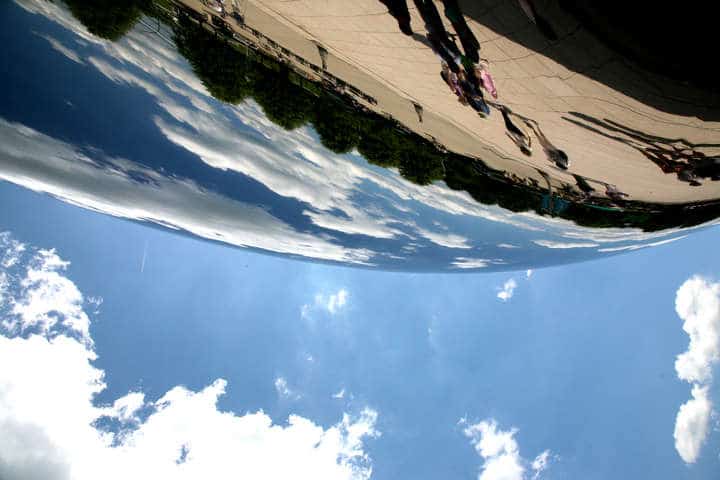Concave mirrors are used in our everyday life. In a concave mirror, the reflecting surface is inwards. The intersection of two reflected rays gives the position of the image. The image’s position, size, and nature formed by a concave mirror depend on the object’s position. The image formation using concave mirrors is a reflection of light by spherical mirrors. There are several simple uses of concave mirrors. This chapter gives a solid base for understanding geometrical optics, and hence the student must understand this thoroughly.

The center of the reflecting surface is the point of the pole ‘P.’ The center of a sphere they form is called the center of curvature ‘C’. The distance between ‘C’ to ‘P’ is the radius of curvature. For a concave mirror, the center of curvature lies at the front of the reflecting surface. The midpoint of ‘C’ to ‘P’ is called the focal point ‘F’ of the respective mirror, also called the principal focus. It gets its name because it lies on the principal axis.
The focal point ‘F’ is where all the rays of light parallel to the principal axis converge. Rays of light incident on any surface will follow laws of reflection. Hence,
The angle of incidence = Angle of reflection
If the rays of light parallel the principal axis, they will always converge at the principal focus. Below mentioned are the properties of the object when reflected on a concave mirror:
| Position of the object | Size of the image | Nature of the image |
| If the image is placed between P and F | The reflection looks enlarged in the mirror | Virtual and erect |
| At F | Highly enlarged | Real and inverted |
| Between C and F | Enlarged | Real and inverted |
| At C | Same size | Real and inverted |
| Beyond C | Diminished | Real and inverted |
| At infinity | Highly diminished (point size) | Real and inverted |
The advantages of using a concave mirror are:
- It can produce a magnified image.
- The reflected light becomes parallel if the light source is located at the principal focus of the mirror.
- At certain conditions, the image produced is real. It allows the image to be projected on a screen.
Simple uses of concave mirrors
1. Solar heater
A solar heater absorbs the heat received by the sun’s light. It converts the sun’s heat into energy. It uses a concave mirror for this operation. When rays of the sun reflect from an object kept at infinity, they converge after reflecting from the surface of a concave mirror. The sun is very far from the earth, and hence the rays of light traveling are parallel to the earth’s surface. When these parallel rays reflect and converge to a point called the focus. This point is boiling since all the sun’s rays are concentrated. If we bring a piece of paper at this point, it will quickly catch fire.
We can use this property for cooking food or heating water. All that needs to be done is to place the container on the stand, which is present near the focus. The container will heat in some time! We can even make roti or papad on this.
2. Astronomical telescopes
Concave mirrors are used to view faraway objects. When the parallel rays of light from the distant star enter the telescope, they reflect on the concave mirror placed on the opposite side. This concave mirror converges all the light at a focal point. So the star’s image is formed at the focal point in space. The secondary mirror is placed near the focal point facing the eyepiece. The eyepiece has another lens that magnifies the image. This way, we can see an enlarged image of a faraway object. This type of telescope is also called the Newtonian telescope since this concept was first used by Isaac Newton.
Other popular uses of concave mirrors
3. Concave mirrors are used in bathrooms since it helps enlarge the image and give our face a better view.
4. Concave mirrors are used for the headlights of a car. When the light is placed at the focal point, the light reflects on the concave curve and travels to the road ahead, giving us a distant view.
5. Projector uses a concave mirror to reflect light to the condenser, increasing the brightness of the image.
6. A dentist’s mirror uses a concave mirror to see an enlarged view of the teeth for ease in viewing while conducting medical procedures. The image produced is upright and enlarged.
7. Used by ENT specialists.
8. The safety peephole of your main door uses one or more concave lenses.
9. Concave lenses are used in spectacles to correct the eye defect called myopia or nearsightedness.
10. Concave lenses are used in torchlight to spread widely the light produced.
11. Instruments like cameras and microscopes mainly use concave lenses.
12. Instruments like scanners, CD players, and medical equipment use laser light. For proper working of this equipment, conclave lenses are used.
Conclusion
Concave mirrors serve any purpose, especially when an enlarged image is required.

